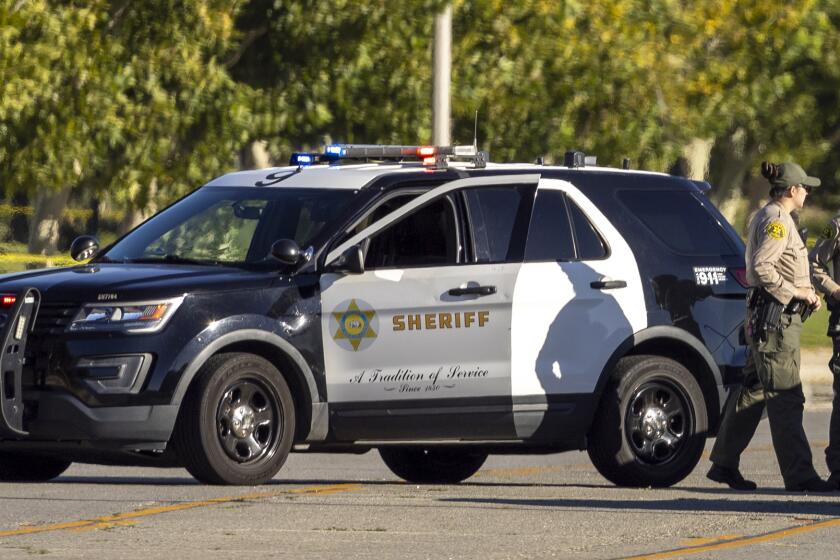Massive Rim fire continues to reshape lives and topography
- Share via
GROVELAND, Calif. — On Day 9, the sweeping Rim fire reshaped lives and topography from pristine wilderness areas to a famed national park to mountain communities that could be in the direct line of fire, depending at any moment on which way the wind blew.
In Groveland, Abby Esteres nervously puffed on a cigarette Sunday morning after her first night back in her Pine Lake Mountain home.
“I haven’t been able to eat not knowing if our house burned down or not,” said the 27-year-old housekeeper, who went through a week of evacuation. “They’re still not saying we’re in the clear. But it’s better. I ate breakfast for the first time in days.”
Near Tuolumne City, firefighters dug trenches, cleared brush, laid heavy water hoses and started backfires to try to divert the blaze around the town as they had in Groveland. Flames were visible from some roofs. A base camp in the area could see 2,500 firefighters by Tuesday if the winds continue to push from the southwest, said a fire official.
But even as firefighters worked furiously to hold a line outside of town, officials warned that this blaze was so hot it could send sparks more than a mile and a half out that could jump lines and start new hot spots. Evacuation advisories remain in effect for Tuolumne City and nearby areas.
On the north edge, the fire — now 134,000 acres — pushed into the Emigrant Wilderness Area and Yosemite National Park. It’s the one side of the fire with a natural last stand: Eventually it will run into granite walls that have snuffed out fires in this region for centuries.
Each day, what the massive blaze does depends on the wind. But officials were particularly attuned to each shift of breeze Sunday because of the weather’s eerie similarities to the day when the fire first exploded out of control.
Flames from what would become one of California’s largest wildfires in recent history were first spotted on a ridge in the Stanislaus National Forest on Aug. 17 by a plane flying to another small fire. An air team was called in and dropped water until nightfall.
“Things looked good. We were feeling we had it pretty much under control,” said Lee Bentley, a spokesman with the U.S. Forest Service.
But the next morning an inversion layer as thick as fog kept planes on the ground. In the afternoon, the smoke lifted and the winds kicked in.
“The fire came boiling out, just cooking,” Bentley said. “It was so hot it created its own weather. It was like dropping a boulder in a pond; fire spread out in every direction.”
Bentley was on his way to set up information kiosks for 11 communities between Groveland and Tuolomne City. He glanced ruefully at the signs thanking firefighters for saving Groveland.
“Everybody in this town has a right to feel nervous. This fire could always turn, depending on which way the wind blows,” he said.
The massive fire presents every challenge: steep slopes, dry fuel, rugged terrain and entire communities possibly in harm’s way.
The base camp and incident post, usually a haven outside fire lines, was a prominent example of the fire’s unpredictability: It’s in the middle of the burn zone, charred land with still-smoldering stumps on both sides.
Firefighters call such complete devastation “the black.” Entire ravines and ridges were a dusty gray moonscape. But some of the land was a “dirty burn” — meaning there were small circles of pine and aspen and even grass and wildflowers in the middle of charcoal-black areas where smoke still curled and embers glowed. The specks of beauty made firefighters nervous: To a fire, they are fuel.
Along Highway 120, a closed main route to Yosemite National Park, motels, resorts and gas stations were ghostly empty — a testament to all of the waitresses and clerks and housekeepers who have lost rent or tuition money. Some 25 miles away, Yosemite Valley, the tourist magnet, remained open.
At the Hetch Hetchy entrance to Yosemite National Park, a trademark stone-and-clapboard ranger station was still standing. But felled and blackened trees went right to the edge of the station, where rangers would usually be checking in backpackers.
At the Hetch Hetchy reservoir, the San Francisco Public Utilities Commission had to shut down two of its three hydroelectric power stations because of the fire. On Friday, Gov. Jerry Brown extended a state of emergency to include the county and city of San Francisco.
The fire has destroyed nine structures and is threatening thousands more.
It’s also changed things that are harder to quantify.
Groveland’s local swimming hole is Rainbow Pools. In years like this, when the water is low, swimmers dive beneath the waterfall. Those wearing goggles can spot big trout — most of them wearing hooks, indicating they once got away from a fisherman.
“Rainbow Pools is — was — so beautiful,” said Eric Edner, a Groveland resident who creates blown glass. “You jump off the rocks into the water and it’s the most fun in the world. They say it’s completely black now.”
On Sunday, Greg Jones, an owner of Dori’s Tea Cottage Cafe, was relieved to open again for business. But he was still mourning the scenic drive from Groveland to his favorite fishing spot at Cherry Lake, a route that goes right through the center of the burn zone.
“There are — were — these areas that are nothing but green ferns, then amazing open meadows,” he said. “A guy came in who runs cattle up there and he said, ‘Greg, you’re not going to believe your eyes.’”
At least twice a day, the fire’s command post releases an update for the surrounding communities. On Sunday, like every day before, it said there was not yet an expected containment date.
Marcum reported from Groveland, Schaefer from Los Angeles.
More to Read
Sign up for Essential California
The most important California stories and recommendations in your inbox every morning.
You may occasionally receive promotional content from the Los Angeles Times.















